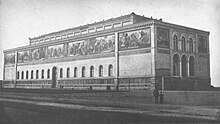August from Voit
August von Voit (born February 17, 1801 in Wassertrüdingen , † December 12, 1870 in Munich ; full name: Richard Jakob August von Voit ) was a German architect . He was the son of the architect Johann Michael Voit .
Life
Voit studied architecture from 1822 at the Royal Art Academy in Munich under Friedrich von Gärtner and continued his education in Italy and France. In 1840 he was Gärtner's successor in his chair, which he held until 1847. After Gärtner's death, senior building officer Voit moved to the state building administration in 1847 as head of the supreme building authority. August von Voit preferred to use the Romanesque style in his buildings , which he copied from North Germanic and Italian patterns.
tomb
August Voit's grave is located in the old southern cemetery in Munich (grave field 17 - row 12 - place 1/2) location . The tomb was designed by August von Voit himself. The execution of the tomb and the marble medallion come from Hermann Oehlmann.
Buildings (selection)
An extensive collection of works and the corresponding plans by August von Voit can be viewed at the Architecture Museum of the Technical University of Munich .
- Interior of the classical Protestant parish church in Rinnthal (1831–1834)
- King's Cross Chapel in Göllheim (1835)
- Protestant church (1839–1840) in Billigheim-Ingenheim - Mühlhofen
- Evangelical parish church (1843–46, together with F. Jodl) in Albersweiler , Am Kanal 2
- Fruit Hall (1843–1846) in Kaiserslautern
- Catholic parish church St. Stephan (1843–46, together with F. Jodl) in Albersweiler , Kirchstrasse 24
- Reconstruction of the Hambacher Schloss (1844–1846) to "Maxburg" as a "Palatinate Hohenschwangau" for the later King Maximilian II ; the work was not finished
- Neue Pinakothek (1846–1853) in Munich
- Glass painting building (1846–1853) on Luisenstrasse in Munich
- Town hall (1851) of Annweiler am Trifels
- Winter garden (1852–1853) for Maximilian II at the Munich Residence
- Chemical laboratory (1852–1855) for Justus von Liebig in Munich
- Glaspalast (1853–1854), modeled on the London Crystal Palace for the first general German industrial exhibition in Munich in 1854
- Glaspalast-Brunnen (1854), designed for the Glaspalast, today on the Weißenburger Platz in Munich-Haidhausen
- Evangelical Lutheran City Church of St. Andreas (1859–1863) in Selb
- Luther Church (1858–1864) in Ludwigshafen am Rhein
- Garden design, garden houses and greenhouses (1860–1867) for the Old Botanical Garden in Munich
- Parish church of the Assumption of Mary (1865–1869) in Weißenhorn
Synagogue buildings
In 1832/1833 the Jewish community in Rülzheim had the new Rülzheim synagogue built by August von Voit. Voit also designed the plans for the Ingenheim synagogue and the synagogues in Herxheim , Kallstadt , Kirchheimbolanden and Speyer .
literature
- Hyacinth Holland : Voit, Richard Jakob August von . In: Allgemeine Deutsche Biographie (ADB). Volume 40, Duncker & Humblot, Leipzig 1896, pp. 220-222.
- Hans-Jürgen Kotzur : Research on the life and work of the architect August von Voit . Dissertation. University of Heidelberg 1978.
- Nikolaus Gerhart, Walter Grasskamp, Florian Matzner (eds.): "Architecture in the Circle of the Arts - 200 Years of the Munich Art Academy" . Festschrift "200 Years of the Munich Art Academy". Verlag Hirmer, Munich 2008, ISBN 978-3-7774-4205-1 .
- "Glaspalast, Munich" , Historical Lexicon of Bavaria.
Web links
- Article by / about Richard Jakob August von Voit in the Polytechnisches Journal
Individual evidence
- ↑ https://mediatum.ub.tum.de/node?id=915824&dir=915824
- ^ August von Voit: The chemical laboratory of the Royal Academy of Sciences in Munich. Built by A. von Voit with the help of Justus von Liebig. Along with an atlas with 13 plates. Brunswick 1859.
| personal data | |
|---|---|
| SURNAME | Voit, August of |
| ALTERNATIVE NAMES | Voit, Richard Jakob August von (full name) |
| BRIEF DESCRIPTION | German architect |
| DATE OF BIRTH | February 17, 1801 |
| PLACE OF BIRTH | Wassertrüdingen |
| DATE OF DEATH | December 12, 1870 |
| Place of death | Munich |





